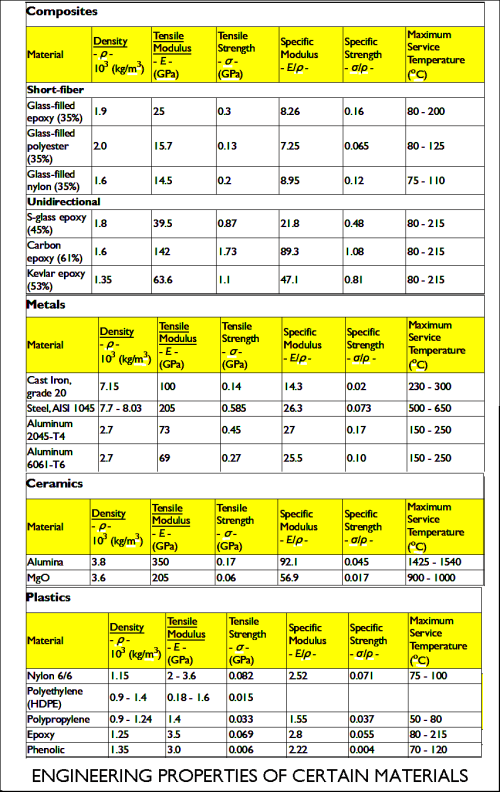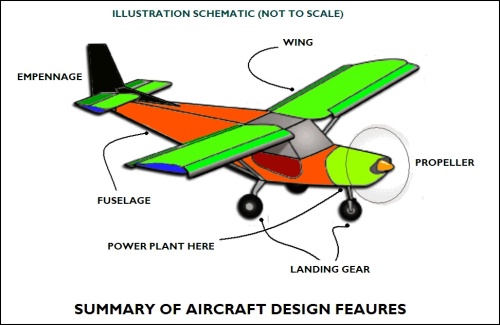TRADITIONAL ENGINEERING MATERIALS
Steel, Aluminum, Brass, Bronzes, Plastics, Polymer Composites and Wood are the most used traditional engineering materials. These have certain properties as follows: (CLICK on the TABLE to ENLARGE have a better View)
Certain Derived Properties of Composites in Fibers, Compared with Steel
| Fiber (40% uni-directional) | Tensile Strength | Sp.wt | Sp. Tensile Strength | Tensile Modulus | Eq Wt Section | Eq. Wt Rigidity Modulus | Cost Factor |
| (MPa) | (kg/m3) | (m) | (GPa) | (cm) Carbon Steel = 1 cm | (Kg-m2) | (Rs/ Kg) | |
| Bamboo | 293 | 600 | 48833 | 18.32 | 13.08 | 3416 | 250 |
| Bamboo-Glass | 350 | 703 | 49786 | 18.23 | 11.16 | 2111 | 255 |
| Hybrid Bamboo1 | 440 | 688 | 63953 | 22.85 | 11.4 | 2282 | 740 |
| Hybrid Bamboo2 | 438.2 | 695 | 63050 | 27.09 | 11.29 | 3248 | 990 |
| E-Glass | 816.8 | 1474 | 55413 | 18.91 | 5.32 | 237.27 | 270 |
| S-Glass | 1104 | 1455 | 75876 | 23.16 | 5.39 | 302.22 | 510 |
| Carbon Fiber | 1222 | 1336 | 91467 | 74.95 | 5.87 | 1263 | 3210 |
| Kevlar 49 | 1298 | 1243 | 104424 | 45.27 | 6.31 | 947.8 | 2210 |
| Boron | 946.5 | 1467 | 64519 | 92.94 | 5.35 | 1186 | 3810 |
| High tensile Steel | 4000 | 7900 | 50632 | 210 | 0.99 | 16.98 | 250 |
| Low Carbon steel | 400 | 7850 | 5095 | 210 | 1 | 17.5 | 60 |
Comparative Design Advantage of Hybrid Bamboo Composites:
In order that we are able to arrive at “optimum” engineered material system for a particular design need, we shall compare the “Rigidity factor” based on Low Carbon Steel (which is the standard structural engineering material)
The average thickness of Steel sheet material needed for the hull of a small 20 ft Dinghy that needs to be “seaworthy’ is 6 mm. The various thickness factors for the Composites (based on equivalent Rigidity factor) are presented below:
| Fiber (40% uni-directional) | Tensile Strength | Sp.wt | Sp. Tensile Strength | Engineered Section | Wt per Sq m | Rigidity Modulus | Fabrication Cost Factor |
| (MPa) | (kg/m3) | (m) | (cm) | Kg | (Kg-m2) | (Rs/ Sq m) | |
| Low Carbon steel | 400 | 7850 | 5095 | 0.6 | 47 | 3.78 | 5640 |
| Bamboo (40%) | 293 | 600 | 48833 | 1.36 | 8.16 | 3.84 | 3060 |
| Bamboo-Glass | 350 | 703 | 49786 | 1.36 | 9.56 | 3.82 | 3657 |
| Hybrid Bamboo1 | 440 | 688 | 63953 | 1.26 | 8.67 | 3.8 | 7700 |
| Hybrid Bamboo2 | 438.2 | 695 | 63050 | 1.2 | 8.34 | 3.9 | 9908 |
| Kevlar 49 | 1298 | 1243 | 104424 | 1.01 | 13.11 | 3.88 | 33319 |
It is noted that we could engineer superior structures using both 40% bamboo composite and bamboo-glass composites. The cost factors would be lesser than that of Low carbon steel structure, even at 50% excess thickness levels in the Bamboo composite structures. That would mean far superior Strength-Rigidity factors in the resultant engineered systems. See the Table below:
| Fiber (40% uni-directional) | Tensile Strength | Sp.wt | Sp. Tensile Strength | Engineered Section | Wt per Sq m | Rigidity Modulus | Fabrication Cost Factor |
| (MPa) | (kg/m3) | (m) | (cm) | Kg | (Kg-m2) | (Rs/ Sq m) | |
| Low Carbon steel | 400 | 7850 | 5095 | 0.6 | 47 | 3.78 | 5640 |
| Bamboo (40%) | 293 | 600 | 48833 | 2.04 | 12.24 | 12.96 | 4590 |
| Bamboo-Glass | 350 | 703 | 49786 | 2.04 | 14.34 | 12.89 | 5485 |
It is further noted that even at double the “minimum thickness” for “steel equivalent” Rigidity factor, the weight factor is only about one-fourth of steel … allowing us to have greater Strength-Rigidity-Economics
For more details on the subject of STRENGTH, RIGIDITY and related Factors, please visit the blog:
http://cr4.globalspec.com/comment/752322/Re-Optimized-Engineering-Materials-Through-Cleantech
Please see the following blogs on this subject for more details:
1. http://cr4.globalspec.com/comment/750225/Re-Optimized-Engineering-Materials-Through-Cleantech
2. http://cr4.globalspec.com/comment/754912/Re-Optimized-Engineering-Materials-Through-Cleantech
We are now looking at the possibility of Designing and constructing a Lightweight AIRCRAFT (Two-Seater) using Hybrid Bamboo Composites. Please see here:
http://cr4.globalspec.com/comment/756431/Re-Optimized-Engineering-Materials-Through-Cleantech



